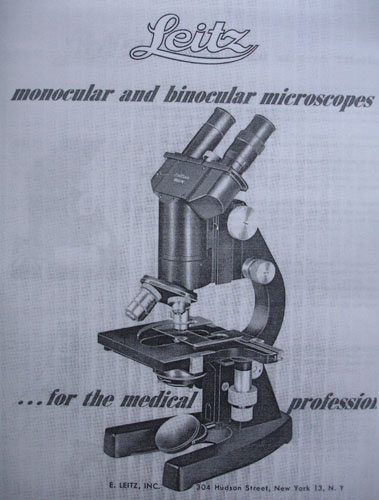
"For the medical profession."
Recently I came across a modestly priced Leitz black enamel microscope on eBay, the price being fair and having owned a large Ortholux I of similar vintage some while back I knew of the quality of the era. Due to lack of space, the big Ortholux along with its substantial power supply eventually had to go but I missed the engineering of that stand. Along with Wild [Switzerland] and Reichert [ Austria], Leitz were making some of the best microscopes in black and steel, sadly this sort of quality will never be seen again.
I quote from a copy of the brochure for this stand.. "Precision and quality are the dominating factors in the manufacture of Leitz microscopes, these universally respected standards are carefully maintained through vigorous and constant inspection"...
The dominating factors today for microscope manufacture are more to do with numbers and maximising profit and include some rather obvious design flaws if one or two of the samples I have tried from the lower end of the range from the better known names. Also what is deemed as acceptable tolerances for alignment of optics and mechanics now seem some what wider than older designs, which considering technology has come a long way in all respects regarding manufacture since the mid 20th century, seems a step backwards.
Described as suitable for the medial profession I guess it would have been used in training colleges, I can't see many doctors requiring one although it would look impressive in his or her surgery! The finish is to the highest standards, just because it was lower down in the hierarchy of Leitz's range there was no compromises here. Even to the smallest detail like the tiniest of screws they are all machined beautifully.

Front cover picture from a copy of the brochure of the period.
Ergonomically this type of microscope is not quite as easy to use compared to research grade modern microscopes as the stage faces away from you, has a mirror as standard needing an external light source [although a simple Leitz illuminator could be plugged in instead of the mirror, see later picture], separate X Y stage controls and high slung focus controls which are now usually placed much closer to the base to reduce fatigue.
The X Y stage controls were improved a couple of years later after this stand [see above picture] using the now standard concentric controls, mine is serial number 403037 dating it to around 1949. Several variants were available as is usual, this being different degrees of sophistication to the stage assembly, condenser, objectives etc. Mine has the Ortholux style stage, a top quality unit with easy to read verniers as shown below.
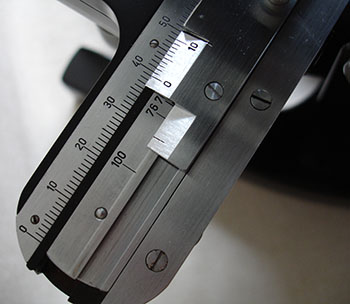
Close-up of the X vernier, close tolerance workmanship and finish is exemplary.
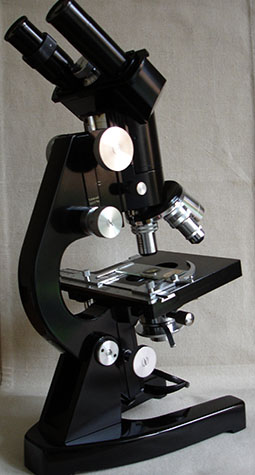
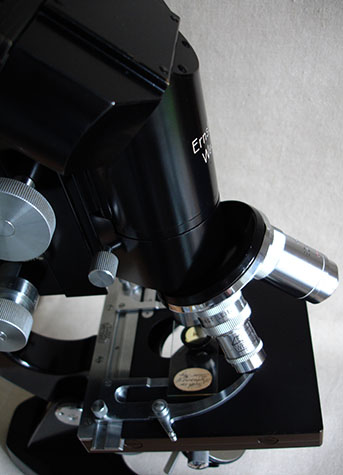
Overview of the microscope.
Measuring around 15" high to eyepieces [a useful fine tuning of height with the binocular head can be achieved by angling back the limb slightly] and substantial in build and weight, all the trade mark quality of the Ortholux in a more compact body. Some of the smaller stands around 12 1/2" high.. more from the brass lacquer days always seem too small to me requiring something beneath the base to bring them up to a comfortable height, the viewing height here is perfect for my setup.
The Leitz GO was a fixed monocular whilst this BO has the interchangeable tube feature. Quick release on a dovetail slide it is an excellent feature that I have already used many times going from monocular to binocular and back again! A 'first surface' mirror was fitted eliminating double reflection of illuminating source, an extremely fragile surface it is easily scratched and best not touched but use a blower brush to remove dust. I am not certain if this was standard as a crude repair had been made to the mirror with a bodged modern alloy bolt 'arrangement' so may be the original flat side of the mirror was damaged at some point and replaced, the mount has been rectified back to something more aesthetically pleasing.
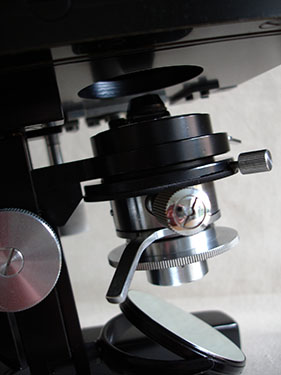
The Berek condenser, note the quality finish even below the stage, this stage action runs smoothly on ball bearings.
Close up of the centrable Berek two diaphragm condenser, a well corrected condenser having a maximum NA of 0.95 dry, the NA 1.40 oil top was supplied at extra cost by Leitz [simply screwed in place of the 0.95, sadly not included here], it has a swing out top lens via the knurled knob for objectives less than 0.25 NA. This is a fine condenser and used also on the Ortholux, [the latter uses a dovetail variant whereas the above is a push fit in a ring mount]. Note that a range of condensers were offered from a simple Abbe to aplanatic-achromatic, I suspect it is probably more likely you will find an Abbe fitted than a Berek as this was quite an expensive optional extra at the time. Although I like this condenser I have not found it suitable for darkfield or centre oblique [COL] illumination.
The knurled ring of the Berek normally adjusts the field iris and the lever above, the condenser iris, although this swaps round for low power objectives [4x and below] where the ring becomes the condenser iris and the lever is rotated for maximum aperture, this type of condenser suits natural light illumination and critical illumination from a large illuminating source.
After a lot of experimentation a critical light source was obtained from a 11 watt Edison Screw low energy [equiv 60 watt filament bulb] fluorescent spot lamp in an old light stand providing good even illumination up to 50x water immersion NA 1.0 but less so for higher power oil immersion, this bulb has a large surface area and a frosted front reduces dark spots from the spiral tube assembly within and remains cool compared to filament bulbs. It still needs to be within about 8" of the mirror to exploit the NA of the condenser using higher power objectives.
An external 15 watt low voltage ac microscope illuminator like the LOMO or Olympus were both found unsuitable with this stand using the 50x objective as neither could provide anywhere near an even light across the full aperture of the condenser even when placed close to the mirror.
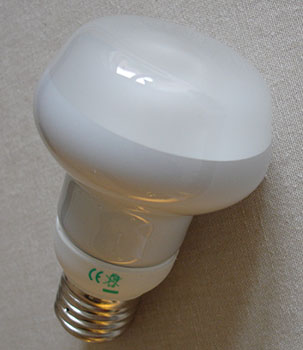
Large 11 watt Edison Screw spot lamp with unmarked 'pearl' surface.
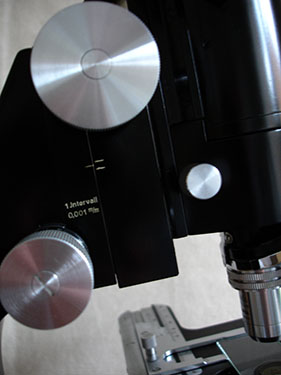
Close-up showing coarse and fine focus, the latter at 0.001mm / interval, many modern scopes aren't as good! Notice the engine turned precision knobs, the small knob to the right is the lock for the nose piece the latter of which is placed in first on the dovetail mount before the tube assembly from above and locked in position. The nose piece is not operated on ball bearings as many modern microscopes but none the worse for it as it is quite small and with close tolerances of component fit and good lube has a smooth action. The fine focus is very light in operation as it doesn't have to move a great deal of mass, the schematic for both coarse and fine controls are shown below.
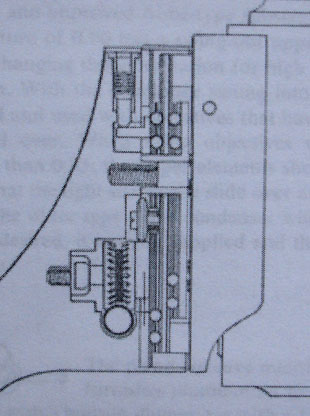
Although not suitable for the high 1.6x factor binocular head, the simple monocular tube with the benefit of no internal optics or prisms shows as previously with using much older Victorian stands how good natural light can be. Nobody can deny the convenience of light at any time on modern scopes with built in light source but observation using natural light with mirrored microscopes can be rewarding too.
While looking at prepared slides specially regarding the use of the lower power objectives natural light can give pleasing results. It can get rather dull on these November and December winter afternoons and still be able to use the 50x water immersion on diatoms, it is the 'nature' of the light too with a neutrality often difficult to achieve with either tungsten or halogen sources. This type of light source suits the Berek condenser well, I have even used it with the 1/12th oil immersion and although on the dull side at this time of year with the weather we have been having still gives good definition.
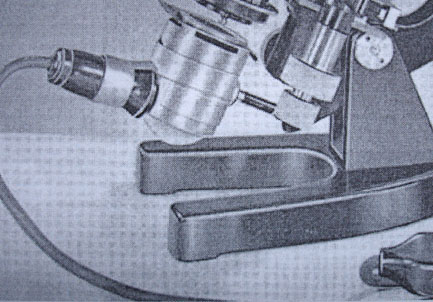
An ungainly fixed intensity Leitz [optional] filament lamp to fit in place of the mirror, notice the near proximity of the illuminating surface to the condenser, in this case an Abbe. Personally speaking I don't fancy all that heat coming straight up!
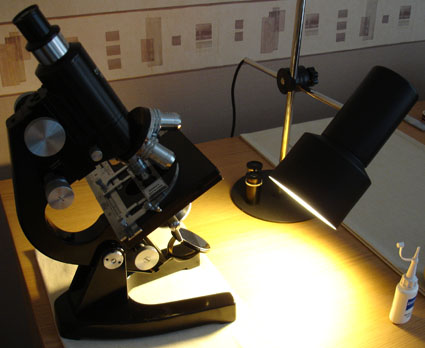
Typical setup with an old lamp stand I have owned from many years ago, this stand has the benefit of a reflective surface inside the bulb enclosure concentrating the light source better and the black and chrome finish suit the style of the microscope well. Shown here is the monocular tube fitted and testing a newly purchased 1/12th NA 1.30 oil immersion objective of the period which turns out to be a competent performer given the limitations of the NA of the Berek condenser with dry top fitted. As the light source runs cool it would be possible to partially baffle the lamp to reduce some of the extraneous light.
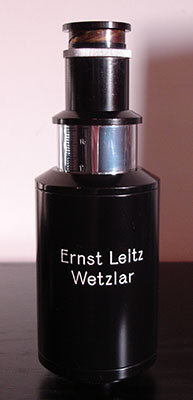
The monocular tube for the stand, quickly inter-changeable and with the benefit of graduated tube length, fitted here with a focusing Leitz 8x eyepiece with internal graticule of the period. This would make a good base for a simple photographic setup using a light weight compact digital camera.
Leitz made a fine series of achromatic, fluorite and apochromatic objectives in the early to mid 20th century for the black enamel microscopes, some were a throw back to older brass lacquered days but as improvements were made in manufacturing and design and coatings for the lenses introduced they became quite different in shape and size from their older siblings as shown below. I am not a great fan of the older Periplan eyepieces as your eyes have to be nearly pinned to the top but within the constraints of the optics they offer a modest field of view and bright images. Although Plan objectives were offered those objectives not labeled Plan still offer better characteristics than some of the cheaper modern optics I have tested specially in regard to chromatic aberration.

On the left, two older style objectives [4x 0.1 'finder' and 10x 0.25] of the correct style for this stand, these are not parfocal with the centre two the left of which is the same 10x objective but factory fitted with a permanent Plezi converter to its base to make it par focal with the later objective range directly to its right, in this case a 2.5x. A much bulkier and even later design is shown on the far right, a 50x water immersion, all work well on this scope. All designed for 170mm tube length.

Nicely chromed, typical eyepieces of the period.
These are the style of eyepieces fitted to this and other Leitz microscopes of the period, later ones had a 'stepped' black section holding the upper lenses with a machine turned main barrel rather than being chromed and longer in length. These Periplans had a larger diameter upper lens and better coatings for improved contrast and benefit of being able to be used by glasses wearers. Early eyepieces of the range above had no coatings for the lenses but it is possible to find later ones in the same style with a deep purple coating the only external difference on mine is a different font used on the eyepiece top.
This stand was in generally good condition on receipt but I still like to remove all the usual parts and have a good clean around with a cloth lightly wettened with soapy water, I often repeat this a few times using light pressure each time not to wipe in and cause scratching of paint or enamel from deposits on the surface as layers of grime are removed. Working around the scope like this can often show up problems as you check moving parts and different sections of the scope. A good buffing up of the black enamel with soft dry cloth previously used with a high quality spray polish brings up the finish to its original lustre [I avoid direct spraying onto the stand]. The same goes for the chrome parts on eyepieces which have their optics removed for cleaning.]
Often the eyepieces will be a tough fit after years of storage or neglect and hard to push in the eyepiece tubes but with a good clean of the chrome and internal surface of the eyepiece tubes on the binocular and monocular head with dampened cotton buds often provides much improvement. Deposits of dirt and old grease can be removed from the alloy and none enamelled parts like the condenser with pure Isopropyl alcohol without fear of the lettering coming off and again a dampened cloth used to remove the usual grime from years of use.
Things to look out for are the binocular head out of collimation, this can be tested accurately by fitting an eyepiece with graticule plus a slide graticule and over laying and aligning the two for a convenient point in the centre with the left eye and then moving the eyepiece with graticule and checking with right eye; any shift vertically and horizontally in divisions. The splitter prism especially is not that well held in place and can shift out of position over time specially whilst transported or badly packed, it can be a time consuming process and not to be taken lightly but I have successfully re-collimated two binocular heads one of which was the Leitz Ortholux which shares the same design as this stand. This one was OK.
Fogging of optical parts.. thread like fungi and thin film deposits on internal and external glass surfaces like the eyepieces reduces contrast and usually can be seen in the field of view. Prism surfaces and corrector lens on the binocular head [protruding on the under side and can be unscrewed] also can suffer from deposits, take great care if cleaning these parts, [an inspection plate held by four tiny screws allows access to the prisms on the binocular head, note also the use of a sticky grease by Leitz on the plate underside edges to keep dust out].
Also on the binocular head the glass covers for the prisms as you look down the eyepiece tubes can get rather dirty but this is not easy to clean but is possible. A good powerful camera blower brush to remove dust and debris before cleaning the glass surfaces with a dampened none abrasive lint free cloth or better quality cotton buds dipped in very diluted washing up liquid, waiting for lenses to dry and then breathe on them and polish up lightly, avoiding a turning motion but across the glass. Some early lens coatings are specially delicate so to avoid damage unless grimy best left alone.
The uppermost lens surface [back focal plane] of the objectives can have small debris, dust, small flecks of black paint from the painted tube and a milky deposits after 50 or 60 years of neglect, often the barrel section can be unscrewed from the lens section for this vintage making inspection and cleaning much easier. The front lens may have grease marks from fingers from previous bad handling, finger grease can damage the optics if left. A good 5 to 10x magnifier is very useful for checking these. Grime like this, specially a grease smear can turn top quality objectives into near useless ones so definitely worth an inspection.
The fine focus should be checked over its full travel within the limits scribed on the stand for smooth operation. Unlike many modern stands this is lightly loaded and it is possible for the grease used on the sliding surfaces to have gone 'sticky' making for erratic operation. The fine focus mechanism [shown earlier] is completely enclosed in the limb so should be dust free. This stand the fine focus is improving with time having some slight hysteresis initially for not being used for a while, this operates on its own independent fully shrouded slider.
The coarse focus was lumpy, the grease had dried out as the sliding surfaces are more open to the atmosphere, racking the tube until it comes off from the top being very careful not to damage the rack and pinion teeth, clean with either white spirit or alcohol the sliding surfaces of all old grease and apply a good medium grade grease like those from Nye, avoid getting alcohol or spirit on the black enamel.
The fitted out box has positions to take the monocular tube on a small metal dovetail, felted placement for the binocular head [upper left] and slots to take an accessory drawer [mid left] and objective/eyepiece carriers on the right. The scope is held firmly in place by burgundy felted wooden blocks and a transit screw can be inserted from the base locking the scope in position. As received it was in a very sorry state with wood dried out, dusty, dirty, scratches and score lines but with wood restorer to bring back colour and lustre, allowed to air and dry over several days and two applications over a few days of Tung oil for wood treatment, it was transformed.
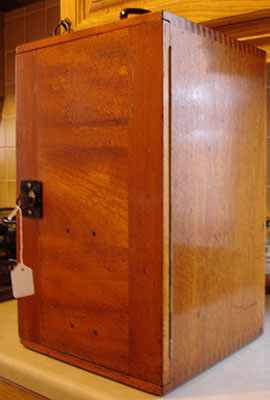
Restored box, the lock is not original having been replaced some time in its life.
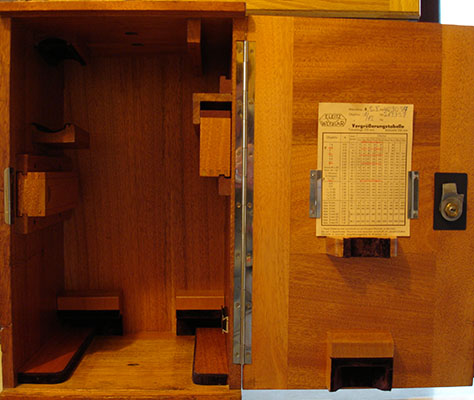
Internal view showing drawers and fitments, a neat small card was placed and glued around the lock mechanism hiding untidy repair work that had been done in the past. It was nice to see the original Leitz objective card list which often get lost over the years, those included with the stand highlighted with red ink, alas reading this shows both the 40x [6L] objective and 1/12th oil immersion are missing, the latter now replaced with one of the period and a 40x being currently sourced.
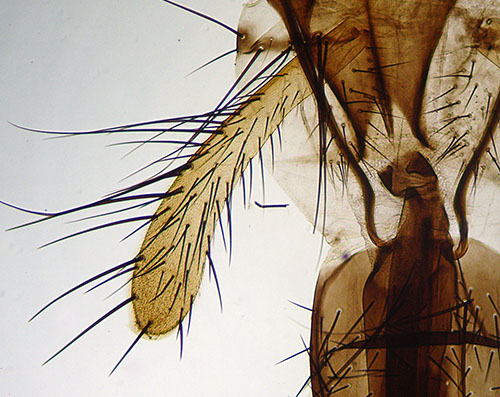
Part of a Blow Fly mouth parts using a Leitz 4x NA 0.1 objective. A quick picture taken on an old Sony compact camera hand held on to an 8x Periplan eyepiece fitted on the monocular tube with rather dull December morning light, this is a small crop of a larger image. The bright background has been reduced in dynamic range by the camera, as seen it was brighter and whiter. I don't have an unimpeded view for the mirror from my observation room as high estate buidlings block much of the sky so some light shading is inevitable.
If engineering quality is a priority and reasonable outlay of funds important, you can't go far wrong with this and other similar vintage microscopes from Leitz. Provided you choose carefully those on offer for sale, avoiding those that look very grimy and affected by storage in damp for long periods there hopefully shouldn't be any major issues. Requiring a little more effort in use than a modern scope it offsets this with user satisfaction, excellent mechanics and optics and shouldn't cost too much to add too when you wish to add further accessories.
Leitz microscopes in black enamel whether a stand like this or the more imposing and expensive Ortholux, Dialux etc offer excellent optics and reliability and were engineered to last, microscopes like these if well looked after by custodians of the future could easily be working and lasting for another 100+ years, how many today would fall into that category. I wonder how many microscopists will be able to know what Zeiss objective they have bought in a decade or two when they come up for sale, the paint wears off the polished barrels unlike the old days of engraving!
Comments to the author Ian Walker are welcomed.
Gordon Couger's very useful resource science-info.net for lots of pdf brochures including the one used here for the schematics, manuals of Leitz, Zeiss et al from many vintages.
Normand & Gregor Overney, "The Excellent Leitz Microscopes with Black Enamel Finish".. a downloadable pdf format authoritative and comprehensive overview of Leitz of the black enamel period including the Ortholux and many more, on Micscape archive.
For those interested you can also read my Leitz Ortholux article from Micscape's archive.
Published in the December 2011 edition of Micscape.
Please report any Web problems or offer general comments to the Micscape Editor .
Micscape is the on-line monthly magazine of the Microscopy UK web site at Microscopy-UK
©
Onview.net Ltd, Microscopy-UK, and all contributors 1995
onwards. All rights reserved.
Main site is at
www.microscopy-uk.org.uk.